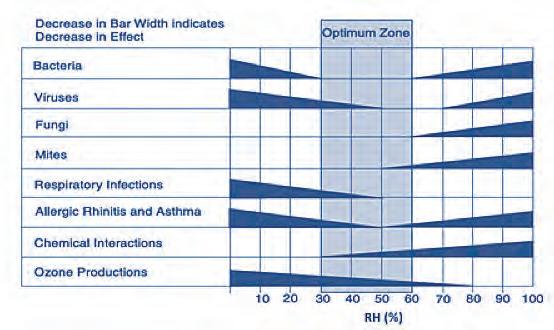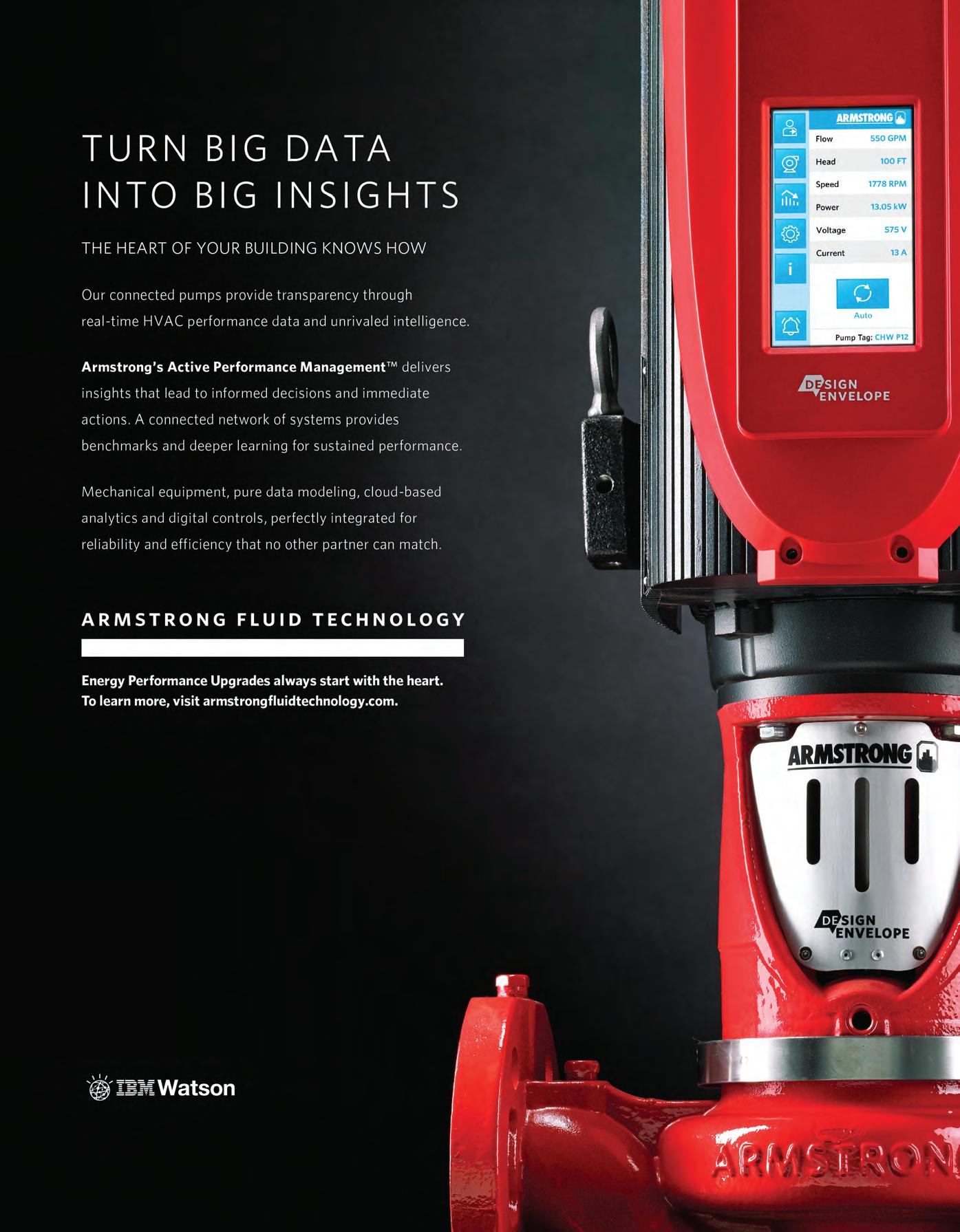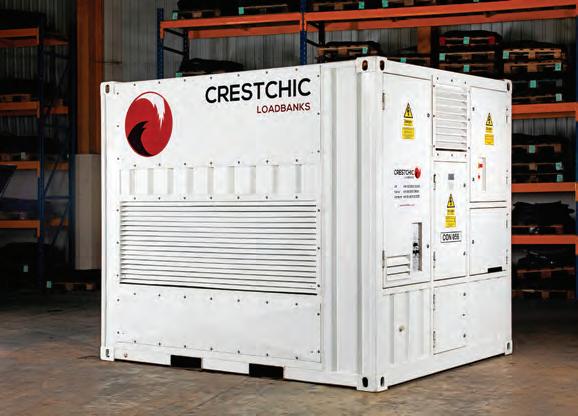
15 minute read
The Warren Report
Andrew Warren is chairman of the British Energy Efficiency Federation
05/06.20
Advertisement
Shaping the world after lockdown
A new normal will emerge from the coronavirus crisis. Ahead there is an opportunity to be grasped to put energy efficiency at the heart of recovery W ill the world after lockdown make delivering energy efficiency any easier than before? How more usage in homes owing to higher occupation levels, and (logically) less in commercial buildings - assuming that energy management is optimised in them, not always true during lockdown.
Will our experience lead to an even social policy, on health policy, on employment policy, has greater determination to deliver a zero acknowledged the enormous unmet potential there is for carbon society? Or will inbuilt inertia wholesale improvement. simply permit a lazy reversion back to business-as-usual? For instance, Strategic greening of the UK building stock President Trump is authorising a bond It is now five years since the Conservative government created bailout worth $750bn for American the National Infrastructure Commission (NIC). Among its fossil fuel companies. consistent subsequent recommendations has been the
There are certain absolute changes strategic greening of the UK building stock, vital to meet the that will hold. Beginning with government’s statutory commitment to be running a net-zeroalterations in location for many whitecarbon economy by 2050. collar workers. Nobody will snigger any Already among the oldest stock in the developed world, it is more at the concept of “working from acknowledged that the vast majority of the buildings we shall home”. Every enterprise, private or be living and working in 30 years from now have already been public, will be seeking to minimise the constructed. Getting these improved is, if anything, an even amount of office space-and often retail greater priority than ensuring that every new construction is space-they need to occupy zero carbon.
Such a significant shift is signalled So the NIC has been arguing for several years that wholesale in the official Government recovery refurbishment of the building stock’s energy performance strategy Our Plan to Rebuild: “Many must be a quintessential infrastructure priority. This concept businesses across the UK have already was immediately adopted by the Scottish government. But the been highly innovative in developing UK government has remained largely noncommittal on the new, durable ways of doing business, subject. such as moving online or adapting to a This March’s Budget promised that “later in the spring the delivery model.” government will publish a landmark National Infrastructure
It continues: “Many of these Strategy, which will set out plans for a once in a generation changes, like increased home transformation of the UK’s economic infrastructure.” But working, have significant benefits, spring has come, and gone. for example, reducing the carbon Following pressure from the Commons’ Business Committee, footprint associated with commuting.” which published yet another excoriating report on the absence Perhaps. But another consequence is of any purposeful residential sector energy efficiency policy, that patterns and amounts of energy the energy minister Kwasi Kwarteng, responded in dead-bat consumption will be changing, with fashion. He said, unsurprisingly: “The Government remains committed to taking the necessary action to improve energy efficiency. It is vital that we give these decisions the proper time and care they deserve.”
For decades, the energy inefficiency of the UK’s housing much have attitudes truly changed stock has long been acknowledged, abroad as a laughing among households, among businesses, stock, at home as a real cause of concern. Every single among bureaucrats, among politicians? serious commentator on energy policy, on climate policy, on
So last month Kwarteng again was promising that “additional climate policies will be set out in due course and finalised in the context of a National Infrastructure Strategy, as outlined at the budget.”
This prompted the government’s official environmental advisors, the Committee On Climate Change (CCC), to re-emphasise that installations of insulation in homes has dropped by over 90 per cent.
Interviewed by the Business Green website, its CEO, Chris Stark, emphasised that: “I think infrastructure policies should change coming out of a crisis like this. This is the time to be doing energy efficiency. I would love to see the government give this the priority it deserves.”
He continued: “At a time when energy prices are falling, it might otherwise get less prominence. So now is the time to do it, because when energy prices start to rise, when demand returns, we will wish that we had fixed the roof when the sun shone.”
The CCC argues that the nation’s “credibility as an international leader rested on taking action at home” ahead of the UK hosting the COP26 UN climate talks next year.
This is surely the time to invest in energy efficiency, renewable energy, clean transport: a green recovery. Delivering green infrastructure and supporting the technologies of the future makes economic sense.
There are encouraging signs from ministers that, intellectually at least, they, unlike Trump, recognise this. In the words of the co-chair of COP26, Business Secretary Alok Sharma: “Every country around the world will face a choice. Between laying the foundations for sound, sustainable growth. Or locking in polluting emissions for decades.”
That is precisely the choice now facing the UK. These fine words must become purposeful actions. Energy efficiency must become a priority infrastructure investment.
Hospitals & Healthcare
For further information on Humidity Solutions visitwww.eibi.co.uk/enquiriesand enter ENQUIRY No. 124
John Barker is managing director of Humidity Solutions
Take aim at viruses


John Barker examines how the threat from viruses and bacteria can be reduced in care homes and hospitals thanks to the careful maintenance of the relative humidity C are homes and hospitals have been of particular focus recently. Attention has focused on how best to assist with limiting the transmission of airborne viruses in these establishments.
This debate forms part of the greater discussion around indoor air quality and how we can protect people who are working, studying or being cared for in increasingly airtight buildings for the majority of their day.
Humidity control as part of the indoor air quality (IAQ) discussion is very much part of the discourse. IAQ has come into focus as we try to replicate good quality fresh air in our homes and buildings irrespective of Humidity control adds to the thermal comfort and reduces the transmission of bacteria and viruses the outside air quality, while being conscious of energy usage which could put greater pressure on climate These studies focus on the observed survival on surfaces and in the air column, and the rates of infection
‘An RH of 50 percent will cut change.
The benefits of humidity control under different environmental conditions. Below are the key virus transmission’ are well documented - creating findings from commonly referenced a more comfortable condition, or recent studies. Links to the studies index, low wind speed, and low adding to thermal comfort (feeling are posted as well: relative humidity are contributors to warmer for a lower air temperature) • maintaining an indoor relative increased MERS-CoV cases (Altamimi and importantly reducing the humidity between 40-60 per cent et al., 2019) transmission of bacteria and viruses. may help to limit the spread and Cold and dry conditions favour
Scientific data does show that to survival of novel coronavirus. influenza transmission in guinea pigs maintain a humidity of 50 per cent Humidification maintains hydrated (Lowen et al., 2007); relative humidity (RH) will reduce the and intact mucosal barriers of • maintaining RH in offices and transmission of viruses by keeping human occupants, resulting in workplaces lowers potential risk the body’s defence mechanism an increase resistance against any for transmission of viral diseases (mucus membrane in the nose and microbial attack. (Dietz et al., 2020); (Wolkoff, 2018 and references throat) moist and able to capture • high temperature, high ultraviolet therein); air-borne bacteria and viruses before they enter the body. Maintaining an RH between 30-60 per cent Fig. 1: Effect of pathogens, microbes, and environmental contaminants on human beings. From Sterling et al. (1985) has been shown to influence the survivorship of viruses and reduce the transmission and infectiousness of viral diseases.
Sterling et al. (1985) (see Fig. 1), synthesised the knowledge at the time into a commonly shared graph of microbial and environmental contaminants on humans at different RH.
Influence of relative humidity More recent studies have taken aim at the influence of relative humidity (RH) on specific families of viruses, like influenza and coronavirus. • while coronaviruses are durable on surfaces relative to influenza viruses, survival rates are reduced at moderate RH of 50 per cent. (Casanova et al., 2010) • the infectiousness of airborne influenza viruses was significantly reduced when RH was above 40 per cent (Noti et al., 2013); • humidification in homes can reduce survival of influenza and promote recovery, by improving restfulness, in sick individuals (Myatt et al., 2010); and • maintaining 40-45 per cent RH in hospitals reduced perceived air dryness and airway symptoms of patients and hospital staff (Nordström et al., 1994).
So, where a humidity control system is not already in place in a facility, is there a practical solution for retrofitting into the office, care home, classroom etc? Mobile humidifiers can be used but they do require regular manual filling and take up floor space.
Commercial systems can be installed into the fresh air supply (AHU), but sometimes this is not possible, or such a system is not already installed into the building.
One excellent solution is to use the HomEvap, a cold water evaporative humidifier, which can be fitted to a heat recovery unit in a house or supplied with a fan to be neatly installed above a false ceiling in an office – out of the way, plumbed in, and providing excellent control automatically. Energy usage ranges between 20-90W dependant on if you require a fan or not. A single humidifier can evaporate five litres of water per hour which will provide humidity control to a space with a volume of approximately 1,200m 3 . The result is a comfortable, healthier environment for net zero energy usage (temperature can be reduced by 2°C when the humidity is raised from 30 – 50 per cent RH for the same thermal comfort).
In a care home the solution is often not to put the humidifier in the day room or bedrooms but to control the humidity in corridors serving these rooms and to allow the humidity to migrate to the areas of concern. This way there is no noise issue (although very low in a bedroom a small fan can still be a nuisance) and maintenance when required does not disturb the occupant of the room.

Hospitals & Healthcare
For further information on Crestchic Loadbanks visitwww.eibi.co.uk/enquiriesand enter ENQUIRY No. 126
Paul Brickman is sales and marketing director at Crestchic Loadbanks
Cutting out the risk
Paul Brickman explores how hospitals and healthcare facilities can ensure that their back up power systems are reliable should the worst happen
For hospitals and healthcare facilities, which often run 24 hours a day, every single day of the year, having access to a reliable power system is absolutely mission-critical. A power cut is, at best, a major inconvenience and operational nightmare and, at worst, a threat to life.
In recent years, the global demand for power has risen sharply. Our expectation to be continually plugged into the latest technology is as evident in industry and healthcare as it is in our home-lives, with technologically advanced equipment increasingly reliant on power to operate. Conversely, in the last few months, the change in our lifestyles, living and working patterns driven by the Coronavirus pandemic have seen our usage patterns fluctuate and the demand on the grid reduce. Hand in hand with these changes in demand, the UK’s energy mix is going through a transition from fossil fuel-generated electricity to an increased prevalence of renewable sources. Combine these factors, and the National Grid is faced with a challenge when it comes to balancing demand and supply - a situation which can lead to unexpected outages.
Needless to say, with people’s lives in their hands, hospital trusts are well-aware of the impact of a break in mission-critical power. From the more obvious effect on lighting, heating and operational infrastructure such as lifts and computer systems, to critical lifesaving equipment in theatres and intensive care units. To mitigate the risk to life and the knock-on effect of having to reschedule appointments in an already overstretched public service, hospital power systems usually take a multi-phased approach to backing up their power supply. A mixture of local battery power and uninterruptible power supply (UPS) systems will handle the immediate risk and prevent critical
The cost of purchasing a load bank is typically a fraction of the cost of the system that it supports

machines from shutting down. This short-term fail-safe is backed-up by generator systems, which are designed to be operational within minutes and have the capacity to take over from the emergency batteries and power buildings and machinery over a longer period.
Robust and reliable Usually installed at build-phase, standby generators are a common solution to provide back-up power if the standard electricity supply is interrupted. They are known for being robust and reliable, offering contractors and facilities managers the reassurance that they’ll do the job and kick in if the worst happens. However, just like any other internal combustion engine, lubrication, cooling systems, fuel system and electrics all need to be tested to ensure faultless operation. Lifting, moving and transporting sensitive equipment, as well as varying on-site conditions such as temperature and humidity, make it absolutely critical that backup power systems are tested in-situ in actual site conditions after being installed and on an ongoing basis thereafter.
While the risks of downtime vary from site to site, one thing remains

constant - interruptions in power supply have the potential to cause operational chaos. Wherever a generator is installed, there is also a need for a load bank - a device used to create an electrical load which imitates the operational or ‘real’ load that a generator would use under normal operational conditions. Load banks are used to test, support, or protect a critical backup power source and ensure that it is working optimally should an outage occur.
Ideally, all generators should be tested annually for real-world emergency conditions using a resistive-reactive 0.8pf load bank. This type of load bank provides a picture of how well an entire system will withstand changes in load pattern while experiencing the level of power that would typically be encountered under real operational conditions.
The inductive loads used in resistive/reactive testing will show how a system will cope with a voltage drop in its regulator. This is particularly important for hospitals, where multiple generators might be operated in parallel. In this type of application, a problem with one generator could prevent other generators from working as they should. With fuel, exhaust and cooling systems also untested, as well as the potential for embedded moisture, an untested system becomes extremely high risk.
The importance of testing is being recognised in many new-build facilities, with the installation of load banks often being specified at the design stage rather than being added retrospectively. The cost of purchasing a load bank is typically a fraction of the cost of the system that it supports, with rental options negating the need for capital expenditure altogether.
Finances aside, the potential cost of power failures in the healthcare sector is unfathomable, putting an overstretched system under additional pressure and causing a very real threat to life. With this in mind, those specifying, commissioning or managing these sites can ill-afford to overlook the critical role of load banks when it comes to ensuring a stable, consistent and constant flow of power.
eibi.co.uk/enquiries Enter 4


Hospitals & Healthcare
For further information on 2EA Consulting Ltd visitwww.eibi.co.uk/enquiriesand enter ENQUIRY No. 128
Sebastian Gray is a director at 2EA Consulting Ltd
Hospital rules and regulations

There are around 1,277 hospitals in the United Kingdom, all subject to a whole raft of legislation. Sebastian Gray examines the most important of these for energy managers O ne of the most important pieces of legislation is the Medium Combustion Plant Directive. This completion of a DEC is mandatory for any building occupied by public authorities, including hospitals.
Since 2011/2012, all public sector bodies are required to produce a
A Display Energy Certificate and have increased from 2018/2019 to Strategy (BEIS) CHP Quality process and identify savings that can its accompanying advisory report, 2020/2021 by 51 per cent. Assurance (CHPQA) Programme. be made. provides a rating between A and G By installing and operating a Good quality electricity produced • For a full breakdown of each piece based upon the building’s actual combined heat and power (CHP) unit by the CHP unit is also exempt from of legislation, please visit www.2ea. operational performance. The a hospital can apply for CCL relief CCL. co.uk/hospitallegislation.
To maintain registration under the CHPQA Programme, CHP heat meters, gas meters and electricity meters need to be verified at regular intervals. This is to ensure that the came into effect on 20th December sustainability report in accordance data being reported is both accurate 2018 for all new medium combustion with the Government Financial and the meters are operating plant greater than 1MW thermal Reporting Manual; this includes a correctly. input. Existing plant, depending discrete section within the Annual The above legislation applies to all upon thermal input rating, will Report covering their performance hospitals. Good energy management need to be covered by the following on sustainability during the year. not only ensures that these facilities dates: thermal input greater than The Climate Change Levy was remain compliant, but can also 5MW – 1st January 2024; and thermal significantly increased in 2019; on the gas used by the CHP after present significant energy and cost Input between 1MW and 5MW – 1st based on energy data for an average registering with the Department savings. An energy consultant can January 2029. hospital, we estimate that CCL costs of Business, Energy & Industrial help you manage the reporting








